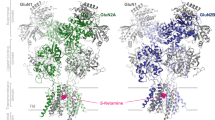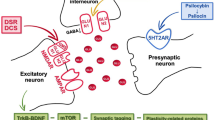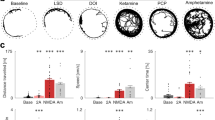Abstract
Phencyclidine, ketamine, and other agents that block NMDA glutamate receptors trigger a schizophrenia-like psychosis in humans and induce pathomorphological changes in cerebrocortical neurons in rat brain. Accumulating evidence suggests that a complex network disturbance involving multiple transmitter receptor systems is responsible for the neuronal injury, and it is proposed that a similar network disturbance is responsible for the psychotomimetic effects of NMDA antagonists, and might also be involved in the pathophysiology of schizophrenia. In the present study we present evidence that serotonergic agents possessing 5HT2A agonist activity prevent NMDA antagonist neurotoxicity in rat brain. It is proposed that 5HT2A agonists may also prevent the psychotomimetic effects of NMDA antagonists. Among the 5HT2A agonists examined and found to be neuroprotective are LSD and related hallucinogens. The apparent contradiction in proposing that these agents might have antipsychotic properties is resolved by evidence linking their hallucinogenic activity to agonist action at 5HT2C receptors, whereas antipsychotic activity would be attributable to agonist action at 5HT2A receptors.
Similar content being viewed by others
Log in or create a free account to read this content
Gain free access to this article, as well as selected content from this journal and more on nature.com
or
References
Ban TA, Lohrena JJ, Lehmann HE . (1961): Observations on the action of Sernyl—A new psychotropic drug. Can Psychiatr Assoc J 6: 150–157
Burris KD, Breeding M, Sanders-Bush E . (1991): (+)lysergic acid diethylamide, but not its nonhallucinogenic congeners, is a potent serotonin 5-HT1C receptor agonist. J Pharmacol Exp Ther 258: 891–896
Cohen BD, Rosenbaum G, Luby ED, Gottlieb JS . (1962): Comparison of phencyclidine hydrochloride (Sernyl) with other drugs. Arch Gen Psychiatry 6: 395–401
Cornea-Hebert V, Riad M, Zerari F, Garcia S, Descarries L, Wu C, Singh S . (1996): Cellular mapping of 5-HT2A receptor protein in adult rat CNS. Soc Neurosci Abstr 22: 1775
Corso TD, Sesma MA, Tenkova TI, Der TC, Wozniak DF, Farber NB, Olney JW . (1997): Multifocal brain damage induced by phencyclidine is augmented by pilocarpine. Brain Res 752: 1–14
Domino EF, Luby ED . (1981): Abnormal mental states induced by phencyclidine as a model of schizophrenia. In Domino EF (ed), PCP (Phencyclidine): Historical and Current Perspectives. Ann Arbor, NPP Books, pp 401–418
Ellison G, Switzer RC . (1993): Dissimilar patterns of degeneration in brain following four different addictive stimulants. Neuroreport 5: 17–20
Ellison G . (1994): Competitive and non-competitive NMDA antagonists induce similar limbic degeneration. Neuroreport 5: 2688–2692
Erard R, Luisada PV, Peele R . (1980): The PCP psychosis: prolonged intoxication or drug-precipitated functional illness? J Psychedelic Drugs 12: 235–251
Farber NB, Price MT, Labruyere J, Nemnich J, St Peter H, Wozniak DF, Olney JW . (1993): Antipsychotic drugs block phencyclidine receptor-mediated neurotoxicity. Biol Psychiatr 34: 119–121
Farber NB, Wozniak DF, Price MT, Labruyere J, Huss J, St Peter H, Olney JW . (1995): Age specific neurotoxicity in the rat associated with NMDA receptor blockade: potential relevance to schizophrenia? Biol Psychiatr 38: 788–796
Farber NB, Foster J, Duhan NL, Olney JW . (1996): Olanzapine and fluperlapine mimic clozapine in preventing MK-801 neurotoxicity. Schizophr Res 21: 33–37
Farber NB, Kim SH, Olney JW . (1997): Costimulation of muscarinic and non-NMDA glutamate receptors reproduces NMDA antagonist neurotoxicity. Soc Neurosci Abstr 23: 2308
Fix AS, Horn JW, Wightman KA, Johnson CA, Long GG, Storts RW, Farber N, Wozniak DF, Olney JW . (1993): Neuronal vacuolization and necrosis induced by the noncompetitive N-methyl-D-aspartate (NMDA) antagonist MK(+)801 (dizocilpine maleate): a light and electron microscopic evaluation of the rat retrosplenial cortex. Exp Neurol 123: 204–215
Fix AS, Wozniak DF, Truex LL, McEwen M, Miller JP, Olney JW . (1995): Quantitative analysis of factors influencing neuronal necrosis induced by MK-801 in the rat posterior cingulate/retrosplenial cortex. Brain Res 696: 194–204
Hoenicke EM, Vanecek SA, Woods JH . (1992): The discrimitive stimulus effects of clozapine in pigeons: Involvement of 5-hydroxytryptamine1C and 5-hydroxytryptamine2 receptors. J Pharmacol Exp Ther 263: 276–284
Javitt DC, Zukin SR . (1991): Recent advances in the phencyclidine model of schizophrenia. Am J Psychiatr 148: 1301–1308
Kim SH, Farber NB, Price MT, Olney JW . (1997): Clonidine suppresses MK801-induced acetylcholine release in rat posterior cingulate cortex: in vivo microdialysis study. Soc Neurosci Abstr 23: 2308
Krystal JH, Karper LP, Seibyl JP, Freeman GK, Delaney R, Bremner JD, Heninger GR, Bowers MB Jr, Charney DS . (1994): Subanesthetic effects of the noncompetitive NMDA antagonist, ketamine, in humans. Psychotomimetic, perceptual, cognitive, and neuroendocrine responses. Arch Gen Psychiatr 51: 199–214
Lahti AC, Koffel B, LaPorte DJ, Tamminga CA . (1995): Subanesthetic doses of ketamine stimulate psychosis in schizophrenia. Neuropsychopharmacology 13: 9–19
Leysen JE, Awouters F, Kennis L, Laduron PM, Vandenberk J, Janssen PAJ . (1981): Receptor binding profile of R 41 468, a novel antagonist at 5-HT2 receptors. Life Sci 28: 1015–1022
Lodge D, Anis NA . (1982): Effects of phencyclidine on excitatory amino acid activation of spinal interneurones in the cat. Eur J Pharmacol 77: 203–204
Lodge D, Aram JA, Church J, Davies SN, Martin D, O'Shaughnessey CT, Zeman S . (1987): Excitatory amino acids and phencyclidine-like drugs. In Hicks TP, Lodge D, McLennan H (eds), Excitatory Amino Acid Transmission. New York, Alan R. Liss Inc., pp 83–90
Luby ED, Cohen BD, Rosenbaum G, Gottlieb JS, Kelley R . (1959): Study of a new schizophrenomimetic drug—Sernyl. Arch Neurol Psychiatr 81: 363–369
Luby ED, Gottlieb JS, Cohen BD, Rosenbaum G, Domino EF . (1962): Model psychoses and schizophrenia. Am J Psychiatr 119: 61–67
Martin GR, Humphrey PPA . (1994): Receptors for 5-hydroxytryptamine: Current perspectives on classification and nomenclature. Neuropharmacology 33: 261–273
Mathews GA, Sofroniew MV, Rattray M . (1996): Differential expression of 5HT2A and 5HT2C serotonin receptor subtype mRNAs by hippocampal interneurons. Soc Neurosci Abstr 22: 1775
Mengod G, Pompeiano M, Martinez-Mir MI, Palacios JM . (1990): Localization of the mRNA for the 5-HT2 receptor by in situ hybridization histochemistry. Correlation with the distribution of receptor sites. Brain Res 524: 139–143
Newcomer JW, Farber NB, Jevtovic-Todorovic V, Selke G, Kelly A, Williams F, Craft S, Olney JW . (1996): NMDA glutamate receptor hypofunction: A model for schizophrenia-like cognitive and behavioral symptoms. Soc Neurosci Abstr 22: 240
Olney JW . (1988): Excitatory transmitters and neuropsychiatric disorders. In Ferrendelli JA, Collins RC, Johnson EM (eds), Neurobiology of Amino Acids, Peptides, and Trophic Factors. Boston, Kluwer Academic Publishers, pp 51–61
Olney JW, Labruyere J, Price MT . (1989): Pathological changes induced in cerebrocortical neurons by phencyclidine and related drugs. Science 244: 1360–1362
Olney JW, Farber NG . (1995a): NMDA antagonists as neuroprotectants, psychotogens, neurotoxins and instructive research tools. Neuropsychopharmacology 13: 335–345
Olney JW, Farber NB . (1995b): Glutamate receptor dysfunction and schizophrenia. Arch Gen Psychiatr 52: 998–1007
Rosenbaum G, Cohen BD, Luby ED, Gottlieb JS, Yelen D . (1959): Comparison of Sernyl with other drugs. Arch Gen Psychiatr 1: 651–656
Schmidt CJ, Sorensen SM, Kehne JH, Carr AA, Palfreyman MG . (1995): The role of 5-HT2A receptors in antipsychotic activity. Life Sci 56: 2209–2222
Sheldon PW, Aghajanian GK . (1990): Serotonin (5-HT) induces IPSPs in pyramidal layer of rat piriform cortex: Evidence for the involvement of a 5-HT2-activated interneuron. Brain Res 506: 62–69
Shen R, Andrade R . (1996): Facilitation of GABAergic neurotransmission by 5-HT2 receptor activation in hippocampus CA1 region. Soc Neurosci Abstr 22: 1775
Acknowledgements
Supported by a research award from the Scottish Rite Benevolent Foundation's Schizophrenia Research Program (NBF), Scientist Development Award DA 00290 (NBF), DA 05072 (JWO), AG 11355 (JWO) and a Research Scientist Award MH 38894 (JWO).
Author information
Authors and Affiliations
Rights and permissions
About this article
Cite this article
Farber, N., Hanslick, J., Kirby, C. et al. Serotonergic Agents That Activate 5HT2A Receptors Prevent NMDA Antagonist Neurotoxicity. Neuropsychopharmacol 18, 57–62 (1998). https://doi.org/10.1016/S0893-133X(97)00127-9
Received:
Revised:
Accepted:
Issue date:
DOI: https://doi.org/10.1016/S0893-133X(97)00127-9
Keywords
This article is cited by
-
Increased spontaneous MEG signal diversity for psychoactive doses of ketamine, LSD and psilocybin
Scientific Reports (2017)
-
Glutamate as a therapeutic target in psychiatric disorders
Molecular Psychiatry (2004)
-
Effects of the 5-HT2A Agonist Psilocybin on Mismatch Negativity Generation and AX-Continuous Performance Task: Implications for the Neuropharmacology of Cognitive Deficits in Schizophrenia
Neuropsychopharmacology (2003)
-
Receptor mechanisms and circuitry underlying NMDA antagonist neurotoxicity
Molecular Psychiatry (2002)
-
Treatment of negative and cognitive symptoms
Current Psychiatry Reports (1999)



